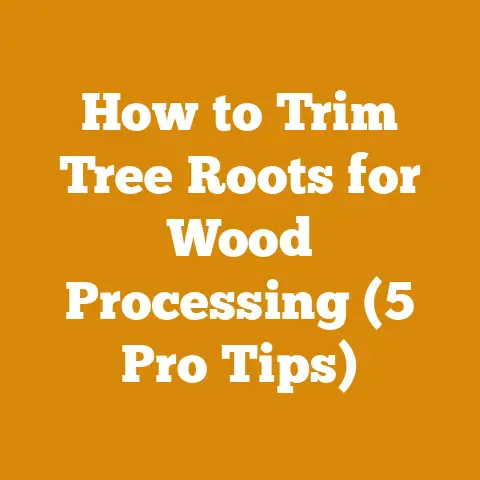How to Estimate Board Feet in a Tree (5 Proven Wood Scaling Tips)
How to Estimate Board Feet in a Tree (5 Proven Wood Scaling Tips) & Budgeting for Your Woodworking Dreams
Ever stood in the woods, gazing up at a majestic tree, and wondered just how much usable lumber is hiding within its bark? I have, countless times. As a woodworker, logger, and someone who’s spent a fair bit of time wrestling with chainsaws and splitting mauls, I’ve learned that accurately estimating board feet in a standing tree is a crucial skill – not just for timber professionals, but for anyone looking to responsibly harvest wood for projects or firewood.
But why is this estimate so important? Because knowing the potential yield helps you make informed decisions about everything from sustainable harvesting to budgeting for your woodworking projects. It’s about minimizing waste, maximizing resource utilization, and ensuring you’re getting the most out of the trees you choose to work with.
1. Understanding Board Feet: The Language of Lumber
Before we dive into the nitty-gritty of estimation, let’s get clear on what a “board foot” actually is. A board foot is a unit of measurement for lumber volume, defined as 1 inch thick, 12 inches wide, and 12 inches long. Think of it as a standard cube of wood, 1 foot by 1 foot by 1 inch.
Why is this important? Because timber prices are often quoted per board foot, and knowing how to calculate it is essential for determining the value of a tree.
The Formula:
The basic formula for calculating board feet in a piece of lumber is:
(Thickness in inches x Width in inches x Length in inches) / 144
For example, a board that is 2 inches thick, 6 inches wide, and 8 feet (96 inches) long would have:
(2 x 6 x 96) / 144 = 8 board feet.
Applying it to Trees:
Estimating board feet in a standing tree is a bit more complex, as we’re dealing with a cylindrical shape rather than a neatly sawn board. We’ll get to specific methods shortly, but the core principle remains the same: we’re trying to approximate the volume of usable lumber that can be extracted from the tree.
2. The Eye Test: Visual Estimation & Initial Assessment
Now, let’s get practical. The first step in estimating board feet is a good old-fashioned visual assessment. I call it the “eye test.” This isn’t about precise measurements; it’s about developing a sense of scale and potential.
What to Look For:
- Tree Species: Different species have different densities and growth patterns, which affect the amount of usable lumber. A straight, clear-grained oak will yield more board feet than a knotty, twisted pine of the same size.
- Tree Height: A taller tree generally means more potential lumber. Look for the point where the tree starts to branch significantly – this is often considered the “merchantable height.”
- Trunk Diameter: The wider the trunk, the more wood there is. Diameter at Breast Height (DBH), measured 4.5 feet above the ground, is a standard measurement used in forestry.
- Tree Form: Is the tree straight and cylindrical, or does it have significant bends, crooks, or forks? Straight trees are easier to mill into lumber.
- Defects: Look for signs of rot, insect damage, or large knots. These defects will reduce the amount of usable lumber.
My Personal Experience: I remember one time I was helping a friend clear some land for a cabin. We came across a massive black walnut tree. Just by looking at it – its height, diameter, and relatively straight trunk – I knew it had the potential to yield a significant amount of high-quality lumber. We ended up milling it ourselves, and it provided enough walnut for the entire interior trim of the cabin. The “eye test” gave us the initial confidence to invest the time and effort.
The Limitations:
While the eye test is a valuable starting point, it’s important to remember that it’s subjective. It’s easy to overestimate or underestimate based on visual impressions alone. That’s why we need more precise methods.
3. The Cruiser’s Stick: A Forester’s Best Friend
The cruiser’s stick, also known as a Biltmore stick, is a specialized tool used by foresters to quickly estimate tree diameter and height. It’s a simple, yet effective, way to get reasonably accurate measurements without having to climb the tree or use complex equipment.
How it Works:
The cruiser’s stick is designed with scales that, when held at a specific distance from the eye, allow you to read the diameter and height of the tree directly from the stick. The scales are based on geometric principles and trigonometric functions.
- Diameter Measurement: To measure diameter, hold the stick at arm’s length (typically 25 inches) and align the zero end with one side of the tree trunk at DBH. Then, without moving your head, note where the other side of the trunk lines up on the diameter scale.
- Height Measurement: To measure height, stand a known distance from the tree (e.g., 66 feet or 100 feet, depending on the stick’s calibration). Hold the stick vertically at arm’s length, aligning the bottom of the stick with the base of the tree. Then, sight to the top of the merchantable height (the point where the tree starts to branch significantly) and read the height on the stick.
Using a Board Foot Volume Table:
Once you have the diameter and height measurements, you can use a board foot volume table to estimate the number of board feet in the tree. These tables are based on empirical data and mathematical models, and they provide a quick and easy way to convert diameter and height into board foot estimates.
Example:
Let’s say you measure a tree with a DBH of 16 inches and a merchantable height of 40 feet. Consulting a board foot volume table (specific to the tree species and region), you might find that a tree with those dimensions is estimated to contain 120 board feet.
Where to Find Cruiser’s Sticks and Volume Tables:
- Forestry Supply Stores: Forestry supply stores sell cruiser’s sticks and other forestry tools.
- Online Retailers: Many online retailers, such as Amazon and Forestry Suppliers, offer a variety of cruiser’s sticks.
- State Forestry Agencies: Your state forestry agency may have resources or publications that include board foot volume tables for your region.
The Accuracy Factor:
Cruiser’s sticks provide a more accurate estimate than the eye test alone, but they still have limitations. The accuracy of the estimate depends on the quality of the measurements, the accuracy of the volume table, and the presence of defects in the tree.
My Tool Tip: I always carry a small notepad and pen with my cruiser’s stick. I jot down the diameter, height, and any observed defects. This helps me keep track of my measurements and make more informed decisions about which trees to harvest.
4. The Doyle Log Scale: A Classic (and Controversial) Method
The Doyle Log Scale is one of the oldest and most widely used log scaling methods in North America. It’s a formula that estimates the board foot volume of a log based on its diameter and length. While it’s still commonly used, it’s also known for its tendency to underestimate the volume of smaller logs.
The Formula:
The Doyle Log Scale formula is:
Board Feet = (Diameter in inches – 4)² x (Length in feet / 16)
How it Works:
- Measure the Diameter: Measure the diameter of the log at the small end, inside the bark. This is the minimum diameter that will be used in the formula.
- Measure the Length: Measure the length of the log in feet.
- Apply the Formula: Plug the diameter and length measurements into the Doyle Log Scale formula to calculate the estimated board foot volume.
Example:
Let’s say you have a log that is 12 inches in diameter and 16 feet long. Using the Doyle Log Scale formula:
Board Feet = (12 – 4)² x (16 / 16) = 8² x 1 = 64 board feet.
The Controversy:
The Doyle Log Scale is known to underestimate the volume of smaller logs (typically those under 20 inches in diameter). This is because the formula assumes a significant amount of waste during the milling process. While this may have been true in the past, modern milling techniques are more efficient and produce less waste.
Why it’s Still Used:
Despite its limitations, the Doyle Log Scale is still widely used because it’s simple, easy to apply, and well-understood by timber buyers and sellers. In many regions, it’s the standard for timber transactions.
Accounting for Underestimation:
If you’re using the Doyle Log Scale, it’s important to be aware of its tendency to underestimate the volume of smaller logs. You may want to adjust your estimates accordingly, or consider using a different log scaling method.
My Personal Anecdote: I once bought a load of logs based on the Doyle Log Scale. I was excited about the price, but when I started milling the logs, I quickly realized that the actual yield was significantly higher than the Doyle estimate. I ended up getting a lot more lumber than I had anticipated, which was a pleasant surprise. This experience taught me the importance of understanding the limitations of the Doyle Log Scale and adjusting my expectations accordingly.
5. The Smalian’s Formula: A More Accurate Approach
Smalian’s Formula is a log scaling method that provides a more accurate estimate of log volume than the Doyle Log Scale, especially for logs with significant taper (the difference in diameter between the large and small ends).
The Formula:
Smalian’s Formula is:
Volume = (Area of Small End + Area of Large End) / 2 x Length
Where:
- Area of Small End = π * (Small End Diameter / 2)²
- Area of Large End = π * (Large End Diameter / 2)²
- Length = Length of the log
How it Works:
- Measure the Diameters: Measure the diameter of the log at both the small end and the large end, inside the bark.
- Measure the Length: Measure the length of the log in the same unit as the diameter (e.g., feet).
- Calculate the Areas: Calculate the area of the small end and the area of the large end using the formulas above.
- Apply the Formula: Plug the areas and length into Smalian’s Formula to calculate the volume.
Converting to Board Feet:
The volume calculated using Smalian’s Formula is typically in cubic feet. To convert to board feet, you’ll need to multiply the cubic foot volume by a conversion factor. The conversion factor depends on the log size and the milling techniques used, but a common approximation is 6 to 8 board feet per cubic foot.
Example:
Let’s say you have a log that is 12 inches in diameter at the small end, 16 inches in diameter at the large end, and 16 feet long.
- Area of Small End = π * (12 / 2)² = 113.1 square inches
- Area of Large End = π * (16 / 2)² = 201.1 square inches
- Volume = (113.1 + 201.1) / 2 x 16 = 2513.6 cubic inches
- Convert to Cubic Feet: 2513.6 cubic inches / 1728 cubic inches per cubic foot = 1.45 cubic feet
- Convert to Board Feet: 1.45 cubic feet x 7 board feet per cubic foot (using an average conversion factor) = 10.15 board feet
The Benefits:
Smalian’s Formula provides a more accurate estimate of log volume than the Doyle Log Scale, especially for logs with significant taper. It takes into account the varying diameter of the log, which results in a more precise volume calculation.
The Drawbacks:
Smalian’s Formula is more complex than the Doyle Log Scale, requiring more measurements and calculations. It also requires a conversion factor to convert cubic feet to board feet, which can introduce some variability into the estimate.
When to Use It:
Smalian’s Formula is a good choice when you need a more accurate estimate of log volume, especially for logs with significant taper. It’s also useful when you’re working with high-value timber or when you want to minimize waste during the milling process.
My Recommendation: I often use Smalian’s Formula when I’m milling logs for specialty projects, such as furniture or musical instruments. The more accurate volume estimate helps me plan my cuts more efficiently and maximize the yield of high-quality lumber.
6. The Importance of Defect Deductions: A Real-World Adjustment
No tree is perfect. They all have imperfections – knots, rot, insect damage, splits, and other defects that reduce the amount of usable lumber. Accurately assessing and deducting for these defects is crucial for getting a realistic estimate of board feet.
Types of Defects:
- Knots: Knots are the remnants of branches that were once attached to the tree. They can reduce the strength and appearance of the lumber.
- Rot: Rot is caused by fungi that decay the wood. It can weaken the wood and make it unusable.
- Insect Damage: Insects can bore into the wood, creating holes and tunnels that weaken the wood.
- Splits and Checks: Splits and checks are cracks in the wood that can reduce its strength and stability.
- Sweep: Sweep is a bend or curve in the log that can make it difficult to mill straight lumber.
- Shake: Shake is a separation between the growth rings in the wood that can weaken the wood.
How to Deduct for Defects:
Deducting for defects is a subjective process that requires experience and judgment. Here are some general guidelines:
- Estimate the Volume of the Defect: Estimate the volume of wood that is affected by the defect. This can be done visually or by measuring the dimensions of the defect.
- Deduct the Volume from the Total Volume: Subtract the volume of the defect from the total volume of the log or tree.
- Consider the Severity of the Defect: The severity of the defect will affect the amount of deduction. A small knot may only require a small deduction, while a large area of rot may require a significant deduction.
- Use a Defect Deduction Table: Some forestry agencies and lumber grading associations provide defect deduction tables that can help you estimate the amount of deduction based on the type and severity of the defect.
Example:
Let’s say you have a log that is estimated to contain 100 board feet. However, the log has a large knot that is estimated to affect 10 board feet of lumber. You would deduct 10 board feet from the total volume, resulting in a net estimate of 90 board feet.
The Art of Judgment:
Deducting for defects is not an exact science. It requires a good understanding of wood properties, milling techniques, and lumber grading standards. The more experience you have, the better you’ll become at accurately assessing and deducting for defects.
My Hard-Earned Lesson: I once underestimated the impact of some hidden rot in a log. I thought I was getting a great deal, but when I started milling it, I discovered that a significant portion of the log was unusable. I ended up with a lot less lumber than I had anticipated, and I learned a valuable lesson about the importance of thorough defect inspection.
7. Budgeting for Wood Processing & Firewood Preparation: From Tree to Treasure
Estimating board feet is just the first step. Now, let’s talk about the money. Whether you’re milling lumber for a woodworking project or preparing firewood for the winter, understanding the costs involved is essential for staying on budget.
Cost Components:
- Timber Purchase or Harvesting Costs: If you’re buying timber, the cost will depend on the species, quality, and volume of wood. If you’re harvesting your own timber, you’ll need to factor in the cost of permits, equipment rental, and labor.
- Tool Costs: Chainsaws, axes, splitting mauls, wedges, log splitters, and other tools are essential for wood processing and firewood preparation. You’ll need to factor in the cost of purchasing, maintaining, and repairing these tools.
- Fuel and Consumables: Chainsaws and log splitters require fuel and oil. You’ll also need to factor in the cost of chainsaw chains, sharpening files, and other consumables.
- Labor Costs: If you’re hiring help, you’ll need to factor in the cost of labor. This can include wages, benefits, and insurance.
- Transportation Costs: You’ll need to transport the logs from the woods to your milling site or firewood processing area. You’ll also need to transport the lumber or firewood to its final destination.
- Milling Costs: If you’re hiring a sawmill to mill your logs, you’ll need to factor in the cost of milling. This can be a per-board-foot charge or an hourly rate.
- Drying Costs: Lumber needs to be dried before it can be used for woodworking projects. You’ll need to factor in the cost of air-drying or kiln-drying.
- Storage Costs: You’ll need to store the lumber or firewood in a dry, protected area. You may need to factor in the cost of building or renting a storage shed.
Data-Backed Insights:
- Timber Prices: Timber prices vary widely depending on the species, quality, and location. According to the USDA Forest Service, the average stumpage price (the price paid for standing timber) for sawtimber in the United States in 2023 was \$200 per thousand board feet. However, prices can range from \$50 per thousand board feet for low-quality pine to \$1000 per thousand board feet for high-quality walnut.
- Equipment Rental Fees: Equipment rental fees vary depending on the type of equipment and the rental period. A chainsaw rental typically costs \$30 to \$50 per day, while a log splitter rental typically costs \$50 to \$100 per day.
- Fuelwood Market Rates: Fuelwood prices vary depending on the region and the type of wood. According to the Energy Information Administration, the average price for a cord of firewood in the United States in 2023 was \$250. However, prices can range from \$150 per cord for softwood to \$400 per cord for hardwood.
Cost Optimization Tips:
- Harvest Your Own Timber: If you have access to timber, harvesting your own timber can save you money on timber purchase costs.
- Rent Equipment: Renting equipment can be more cost-effective than buying it, especially if you only need it for occasional use.
- Buy Used Equipment: Buying used equipment can save you money on equipment costs.
- Sharpen Your Chainsaw: A sharp chainsaw cuts more efficiently and uses less fuel.
- Air-Dry Your Lumber: Air-drying lumber is a more cost-effective option than kiln-drying, although it takes longer.
- Negotiate Prices: Don’t be afraid to negotiate prices with timber buyers, equipment rental companies, and sawmill operators.
- Plan Ahead: Planning your wood processing and firewood preparation projects in advance can help you identify potential cost savings.
My Budgeting Success Story: I once built a woodshed using lumber that I harvested and milled myself. By carefully planning the project, renting equipment instead of buying it, and air-drying the lumber, I was able to save over 50% compared to buying the lumber from a lumberyard.
8. Case Studies in Cost Management: Real-World Examples
Let’s look at a couple of case studies to illustrate how cost management can impact wood processing and firewood preparation projects.
Case Study 1: Small-Scale Logging Operation
A small-scale logger in the Pacific Northwest wants to harvest 10,000 board feet of Douglas fir timber. He estimates the following costs:
- Stumpage Fee: \$100 per thousand board feet = \$1,000
- Permits: \$200
- Equipment Rental (Chainsaw, Skidder): \$1,500
- Fuel and Consumables: \$500
- Labor (Self): \$2,000 (estimated value of his own time)
- Transportation: \$800
Total Estimated Costs: \$6,000
Cost per Board Foot: \$6,000 / 10,000 board feet = \$0.60 per board foot
By carefully managing his costs, the logger can harvest timber at a cost of \$0.60 per board foot. He can then sell the timber to a sawmill or lumberyard for a profit.
Case Study 2: Firewood Preparation for Home Heating
A homeowner in New England wants to prepare 10 cords of firewood for home heating. She estimates the following costs:
- Firewood Purchase: \$200 per cord = \$2,000
- Equipment Rental (Log Splitter): \$500
- Fuel and Consumables: \$200
- Labor (Self): \$1,000 (estimated value of her own time)
- Transportation: \$100
Total Estimated Costs: \$3,800
Cost per Cord: \$3,800 / 10 cords = \$380 per cord
By preparing her own firewood, the homeowner can save money compared to buying firewood from a firewood supplier.
9. The Future of Wood Scaling: Technology & Innovation
The world of wood scaling is evolving. Technology is playing an increasingly important role, offering new tools and techniques for more accurate and efficient estimation.
Laser Scanning: Laser scanning technology can be used to create 3D models of trees and logs. These models can be used to accurately measure diameter, height, and volume, as well as to identify defects.
Drone Technology: Drones can be used to capture aerial images of forests. These images can be used to estimate timber volume and to assess forest health.
Software Applications: Software applications are available that can help you estimate board feet, deduct for defects, and manage your wood processing and firewood preparation projects.
The Digital Forester: I envision a future where foresters and woodworkers are equipped with handheld devices that can instantly scan a tree, assess its defects, and provide an accurate estimate of its board foot volume. This technology will revolutionize the way we manage and utilize our forest resources.
My Tech Prediction: I believe that laser scanning technology will become more affordable and accessible in the coming years. This will make it easier for small-scale loggers and woodworkers to accurately estimate timber volume and maximize their yields.
10. Actionable Takeaways & Next Steps: Your Woodworking Journey Begins
Estimating board feet in a tree is a valuable skill for anyone involved in wood processing or firewood preparation. By using the techniques and tips outlined in this article, you can make more informed decisions about harvesting, milling, and budgeting for your projects.
Key Takeaways:
- Understand Board Feet: Know what a board foot is and how to calculate it.
- Master Visual Estimation: Develop your eye for assessing tree size, form, and defects.
- Use a Cruiser’s Stick: Learn how to use a cruiser’s stick to measure diameter and height.
- Apply Log Scaling Methods: Understand the Doyle Log Scale and Smalian’s Formula.
- Deduct for Defects: Accurately assess and deduct for defects.
- Budget Wisely: Understand the costs involved in wood processing and firewood preparation.
- Embrace Technology: Explore new technologies for more accurate and efficient wood scaling.
Next Steps:
- Practice Your Skills: Go out into the woods and practice estimating board feet in different types of trees.
- Invest in Tools: Purchase a cruiser’s stick and other essential tools.
- Learn from Experts: Attend workshops or seminars on wood scaling and timber management.
- Network with Professionals: Connect with foresters, loggers, and woodworkers in your area.
- Start Your Project: Plan your next woodworking or firewood preparation project and put your new skills to the test.
I hope this article has provided you with valuable insights and practical guidance for estimating board feet in a tree and budgeting for your wood processing and firewood preparation projects. Remember, the journey from standing timber to finished product is a rewarding one, filled with challenges and opportunities. Embrace the process, learn from your mistakes, and never stop exploring the wonderful world of wood. Happy woodworking!






